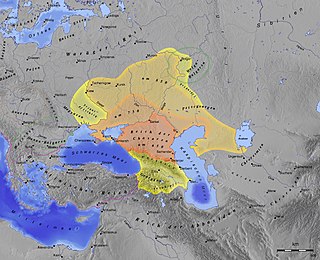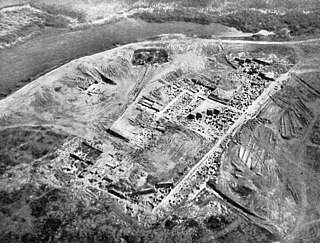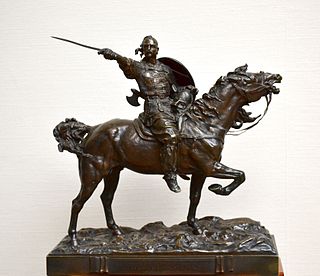
The Khazars were a nomadic Turkic people that, in the late 6th-century CE, established a major commercial empire covering the southeastern section of modern European Russia, southern Ukraine, Crimea, and Kazakhstan. They created what for its duration was the most powerful polity to emerge from the break-up of the Western Turkic Khaganate. Astride a major artery of commerce between Eastern Europe and Southwestern Asia, Khazaria became one of the foremost trading empires of the early medieval world, commanding the western marches of the Silk Road and playing a key commercial role as a crossroad between China, the Middle East and Kievan Rus'. For some three centuries the Khazars dominated the vast area extending from the Volga-Don steppes to the eastern Crimea and the northern Caucasus.

Sarkel was a large limestone-and-brick fortress in what is now Rostov Oblast of Russia, on the left bank of the lower Don River.

Sviatoslav or Svyatoslav I Igorevich was Prince of Kiev from 945 until his death in 972. He is known for his persistent campaigns in the east and south, which precipitated the collapse of two great powers in Eastern Europe, Khazaria and the First Bulgarian Empire. He conquered numerous East Slavic tribes, defeated the Alans and attacked the Volga Bulgars, and at times was allied with the Pechenegs and Magyars (Hungarians).

Atil, also Itil, was the capital of the Khazar Khaganate from the mid-8th century to the late 10th century. It is known historically to have been situated along the Silk Road, on the northern coast of the Caspian Sea, in the Volga Delta region of modern Southern Russia. Its precise location has long been unknown.

Samandar was a city in Khazaria, on the western shore of the Caspian Sea, in what is now Daghestan. At some later date, it may have been moved inland to some areas near the present-day village of Shelkovskaya in the modern Chechen Republic.

The Volga is the longest river in Europe. Situated in Russia, it flows through Central Russia to Southern Russia and into the Caspian Sea. The Volga has a length of 3,531 km (2,194 mi), and a catchment area of 1,360,000 km2 (530,000 sq mi). It is also Europe's largest river in terms of average discharge at delta – between 8,000 m3/s (280,000 cu ft/s) and 8,500 m3/s (300,000 cu ft/s) – and of drainage basin. It is widely regarded as the national river of Russia. The hypothetical old Russian state, the Rus' Khaganate, arose along the Volga c. 830 AD. Historically, the river served as an important meeting place of various Eurasian civilizations.
The Schechter Letter, also called the Genizah Letter or Cambridge Document, was discovered in the Cairo Geniza by Solomon Schechter in 1912. It is an anonymous Khazar letter discussing several matters including the wars of the early 940s, involving the Byzantine Empire, the Khazar Khaganate, and Kievan Rus'. Scholars have debated its authenticity.
Saqsin, also known as Saksin and Saksin-Bolgar, was a medieval city that flourished from the eleventh to the thirteenth centuries. It was situated in the Volga Delta, or in the Lower Volga region, and was known in pre-Mongol times as Saksin-Bolgar, which in Mongol times became Sarai Batu. It was mentioned by the Arab geographer al-Gharnati and the Persian Qazwini, among others, and recorded as "the land of the Saksins" in the report of Friar Benedict of Poland about the 1246 trip of Giovanni da Pian del Carpine through the camp of Mongol prince Batu Khan on the shores of the Volga. S.A. Pletneva locates Saksin between present Volgograd and Akhtubinsk.
The Brutakhi were a Jewish polity of uncertain location and origin during the early 13th century.
The Krymchaks are Jewish ethno-religious communities of Crimea derived from Turkic-speaking adherents of Rabbinic Judaism. They have historically lived in close proximity to the Crimean Karaites, who follow Karaite Judaism.

Saltovo-Mayaki or Saltovo-Majaki is the name given by archaeologists to the early medieval culture of the Pontic steppe region roughly between the Don and the Dnieper Rivers, flourishing roughly between the years of 700 and 950. The culture's type sites are Mayatskoye near the Don and Verkhnii Saltiv by the Donets.
Obadiah was the name of a Khazar ruler of the late eighth or early ninth century. He is described as coming from among "the sons of the sons" of Bulan, but whether this should be taken literally to mean that he was Bulan's grandson, or figuratively to imply a more remote descent, is unclear. King Joseph's Reply claimed that Obadiah strengthened Rabbinic Judaism and Hebrew proficiency in Khazaria by building synagogues and schools and inviting Jewish sages to the country. In Sefer ha-Ittim, Judah ben Barzillai's list of Khazar Jewish kings lacked Obadiah's name, and several scholars have concluded from this that Obadiah was a fictional character. He was succeeded by his son Hezekiah.
A purported Khazar ruler of the late tenth century CE who ruled over a Khazar successor-state in the Taman region. David is mentioned in a single document dated AM 4746 which contains a reference to "our lord David, Prince of the Khazars, who lives in Taman." The document in question is of uncertain authenticity, as it passed through the hands of Abraham Firkovich, who on occasion forged documents and inscriptions. Dan Shapira expressed certainty that the document is a forgery by Firkovich and his viewpoint was adopted by other scholars who cited him including Michael Toch and Kevin Brook.
Serach was a medieval Jewish woman who, as per the Schechter Letter, was married to the Khazar ruler Sabriel. She encouraged her husband to convert to Judaism and he did so. Serach is not mentioned in the Khazar Correspondence or the Kuzari.

The Caspian expeditions of the Rus' were military raids undertaken by the Rus' between the late 9th century and c. 1041 on the Caspian Sea shores, of what are nowadays Iran, Dagestan, and Azerbaijan. Initially, the Rus' appeared in Serkland in the 9th century travelling as merchants along the Volga trade route, selling furs, honey, and slaves. The first small-scale Viking raids took place in the late 9th and early 10th century. The Rus' undertook the first large-scale expedition in 913; having arrived on 500 ships, they pillaged in the Gorgan region, in the territory of present-day Iran, and more to the west, in Gilan and Mazandaran, taking slaves and goods. On their return, the northern raiders were attacked and defeated by the Khazars in the Volga Delta, and those who escaped were killed by the local tribes in the middle Volga.

In the Middle Ages, the Volga trade route connected Northern Europe and Northwestern Russia with the Caspian Sea and the Sasanian Empire, via the Volga River. The Rus used this route to trade with Muslim countries on the southern shores of the Caspian Sea, sometimes penetrating as far as Baghdad. The powerful Volga Bulgars formed a semi-nomadic confederation and traded through the Volga river with Viking people of Rus' and Scandinavia and with the southern Byzantine Empire Furthermore, Volga Bulgaria, with its two cities Bulgar and Suvar east of what is today Moscow, traded with Russians and the fur-selling Ugrians. Chess was introduced to Medieval Rus via the Caspian-Volga trade routes from Persia and Arabia.

Gentlemen of the Road is a 2007 serial novel by American author Michael Chabon. It is a "swashbuckling adventure" set in the khaganate of Khazaria around AD 950. It follows two Jewish bandits who become embroiled in a rebellion and a plot to restore a displaced Khazar prince to the throne.

The Khazar hypothesis of Ashkenazi ancestry, often called the Khazar myth by its critics, is a largely abandoned historical hypothesis that postulated that Ashkenazi Jews were primarily, or to a large extent, descended from Khazars, a multi-ethnic conglomerate of mostly Turkic peoples who formed a semi-nomadic khanate in and around the northern and central Caucasus and the Pontic–Caspian steppe. The hypothesis also postulated that after collapse of the Khazar empire, the Khazars fled to Eastern Europe and made up a large part of the Jews there. The hypothesis draws on medieval sources such as the Khazar Correspondence, according to which at some point in the 8th–9th centuries, a small number of Khazars were said by Judah Halevi and Abraham ibn Daud to have converted to Rabbinic Judaism. The scope of the conversion within the Khazar Khanate remains uncertain, but the evidence used to tie the subsequent Ashkenazi communities to the Khazars is meager and subject to conflicting interpretations.

Semikarakorsk Fortress was an early medieval Khazar fortification situated near the city of Semikarakorsk.









